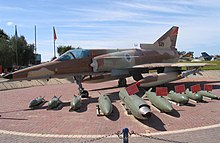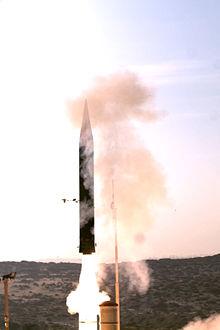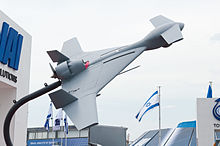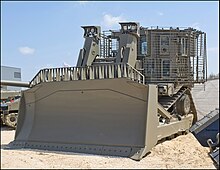Israel Aerospace Industries
 | |
| Company type | Government-owned corporation |
|---|---|
| TASE: ARSP.B1 | |
| Industry | Aviation, Defense |
| Predecessor | Bedek Aviation Company |
| Founded | 1953 |
| Founder | Al Schwimmer Shimon Peres |
| Headquarters | , |
Key people | Boaz Levy (CEO) |
| Products | Military weapons and equipment |
| Services | Aircraft maintenance Aircraft upgrade |
| Revenue | |
Number of employees | 15,000 |
| Divisions | Bedek Aviation Group Commercial Aircraft Group Military Aircraft Group Systems, Missiles & Space Group |
| Subsidiaries | ELTA Systems |
| Website | www |
Israel Aerospace Industries (Hebrew: התעשייה האווירית לישראל, romanized: ha-ta'asiya ha-avirit le-yisra'el), is Israel's major aerospace and aviation manufacturer, producing aerial and astronautic systems for both military and civilian usage. It has 14,000 employees as of 2021. IAI is state-owned by the government of Israel.
IAI designs, develops, produces and maintains civil aircraft, drones, fighter aircraft, missile, avionics, and space-based systems.
IAI's main focus is engineering, aviation and high-tech electronics, though it also manufactures military systems for ground and naval forces. Many of these products are centered on the core needs of the Israel Defense Forces (IDF). Other offerings are marketed to numerous foreign militaries.
History
[edit]Israel Aerospace Industries was founded in 1953 as Bedek Aviation Company under the initiative of Shimon Peres, then director general of the Ministry of Defense, in order to maintain Israel Defense Forces aircraft.[1] The company originally had 70 employees and recruited American born aviation expert Al Schwimmer as the company's founder and first president.[2]
First aircraft manufacturing
[edit]
In 1959 Bedek began manufacturing its first aircraft, a V-tailed twinjet trainer of French design, the Fouga CM.170 Magister, locally called Tzukit (monticola). The Tzukit became the Israeli Air Force principal trainer for 50 years. The IAI Tzukit was also used in the 1967 Six-Day War by 147 Squadron as a close support aircraft, attacking targets on the Egyptian front during the first day of the war, when Israel's more capable combat aircraft were deployed against Arab air bases and aircraft.[3] They were then deployed against Jordanian forces, including armour, on the West Bank. The Magister proved effective at the close-support mission albeit with heavy casualties, with six being lost.[4]
The first aircraft to be fully designed and built by IAI, the IAI Arava short take-off and landing transport aircraft, first flew in 1969 after three years of development.[5]
The French embargo impact
[edit]
In response to the French embargo, IAI began developing its own fighter aircraft, a derivative of the Mirage 5 called the IAI Nesher ("hawk"), in 1968. The Nesher entered service in 1971, in time for the Yom Kippur War. The Nesher was followed by the IAI Kfir ("lion cub"), which was developed as a result of Israel's need for adapting the Dassault Mirage III to the specific requirements of the Israeli Air Force. The Kfir entered service with the IAF in 1975, the first units being assigned to the 101st "First Fighter" Squadron. Over the following years, several other squadrons were also equipped with the new aircraft. The Kfir's first recorded combat action took place on 9 November 1977, during an Israeli air strike on a training camp at Tel Azia, in Lebanon. The only air victory claimed by a Kfir during its service with the IAF occurred on 27 June 1979 when a Kfir C.2 shot down a Syrian MiG-21.[5]
The IAI Kfir has been exported to Colombia, Ecuador, Sri Lanka and was leased to the US Navy and the US Marine Corps from 1985 to 1989, to act as adversary aircraft in dissimilar air combat training.[6]
Diversification
[edit]
In 1969 IAI acquired North American Rockwell's Jet Commander series of business aircraft. This became the basis for the IAI Westwind line. Work on an improved Westwind – named the Astra – began in the late 1970s[7] by stretching the fuselage and designing a new swept wing, with the first prototype flight occurring on 19 March 1984.[8] The first production Astra flew on 20 March 1985, FAA certification came on 29 August 1985 and customer deliveries started in 1986.[8]
In the 1960s, IAI developed the Gabriel anti-ship missile and the Elta Electronics Industries subsidiary developed an inexpensive aircraft radar which would become a successful export item. In the 1970s IAI developed the Dabur class patrol boat.[5]
In the 1970s IAI also entered the Unmanned aerial vehicle (UAV) market with the development of the IAI Scout. In 1984, IAI formed a joint venture with rival Israeli company Tadiran to market both companies' UAV's, the Tadiran Mastiff and the IAI Scout.[9]
Developing the maintenance, repair and overhaul business
[edit]By 1980s the original Bedek maintenance business was conducting extensive overhauls on dozens of different aircraft types, working on engines as well as airframes and interiors, IAI could provide more comprehensive refurbishments than even the aircraft manufacturers themselves. The unit had 4,000 employees by the mid-1980s and overhauled a huge range of aircraft, from propeller-driven trainers to airliners; including big civil aviation programs, such as conversion of Boeing 747s to freighters.[10]
The Lavi program
[edit]
In 1980 the Government of Israel decided to use the experience IAI had accumulated to develop and manufacture a modern fighter plane to be the mainstay of the Israel Air Force. The aircraft, called the IAI Lavi, was to be a superior attack aircraft with advanced weapons systems. It had its rollout in July 1986 and successful maiden flight in December 1986.[11]
In August 1987, after extensive government deliberations, the decision was made (by one vote) to cancel the Lavi program, due to the questioning of Israel's economic ability to support the cost of such an extensive program.[12] This led to a serious crisis at IAI which necessitated a major reorganization of the company's structure and business strategy; the company's work force of more than 22,000 people was cut by 5,500 in 1988. However, the Lavi program was credited with developing a number of advanced technologies that IAI was able to market.[11]
1990s onwards—export led growth
[edit]







By 1989 IAI posted a profit of $11.8 million on sales of $1.28 billion. The company had four divisions—Aircraft, Aviation, Electronics, and Technologies—and 17 factories. IAI was established as a world leader in upgrading aircraft. Planes such as the Vietnam-era McDonnell Douglas F-4 Phantom II were modernized with advanced avionics and weaponry.
In the 1990s IAI entered the space race with the AMOS communications satellites, Ofeq observation satellites and the Shavit space launcher.[11]
In December 1997, the IAI Galaxy, a business jet with an intercontinental range developed as a joint venture Galaxy Aerospace with the Hyatt Corporation, made its first flight and entered service in 2000. In May 2001, General Dynamics' Gulfstream Aerospace bought IAI's Galaxy Aerospace Co. L.P. unit for $330 million, although IAI continues to perform most of the assembly and development of the jets which are marketed by Gulfstream.[13]
In 2003, Israel Aircraft Industries attempted to enter the VLJ (very light jet) Market by launching the Avocet ProJet, a 6–8 seat high utilization air taxi with a list price almost half the cost of the least expensive business jet available at that time. In early 2006, ProJet development stalled after a major undisclosed US OEM pulled out of the program due to unspecified reasons.[14]
The company was working with the Aviation Technology Group on a military trainer version of the ATG Javelin, a fighter style personal jet. The version being developed would have competed against a large field of jet trainers at a much lower cost of acquisition and maintenance. ATG halted development of the Javelin in 2008 due to a lack of funds.
In March 2004 IAI signed a $1.1 billion contract with India to install three EL/W-2090 AWACS systems on Russian-made Ilyushin Il-76 transports, which are based in part on IAI's earlier EL/M-2075 Phalcon platform which was developed in the 1990s.[15] In the late 2000s IAI developed the follow-on EL/W-2085 system which is installed on heavily modified Gulfstream G550 aircraft and which besides serving in the IAF were also sold to Singapore and Italy.
On 6 November 2006, IAI changed its corporate name from "Israel Aircraft Industries Ltd." to "Israel Aerospace Industries Ltd."; to more accurately reflect the current scope of the firm's business activities, which includes not just aircraft, but also systems, satellites and launchers, as well as maritime and ground systems.
On 13 April 2009, the Moscow Times reported that the Russian Defense Ministry had signed an agreement with Israel Aerospace to purchase $50 million in pilotless drone aircraft. The contract reportedly includes three types of UAVs manufactured by the company.[16]
In January 2012, IAI announced a sale of $1.1 billion of defense systems to an Asian country. The deal has been signed but the company did not name the buyer. It was reported that the sale will include IAI aircraft, missiles and intelligence technologies.[17]
On 4 September 2012, the Gulfstream G280, a new twin-engine business jet built by IAI, received full certification from the Federal Aviation Administration (FAA).[18]
IAI is a member of the prestigious Trace International and Society of Corporate Compliance and Ethics (SCCE) organizations and recognized in the Transparency International April 2015 report to be in the top third of worldwide defense companies for its ethics and anti-corruption programs.[19]
In April 2018, IAI systems were observed in a film made by the Azerbaijan Army, specifically the IAI Harop loitering munition system, resulting in criticism from the Armenian government concerning the supply of Israeli arms to the Azeri army.[20] In 2019, IAI sells drone defense systems to governments to be placed in sensitive areas such as borders, army bases, or power plans, and provides equipment to shoot down military drones as well. It also sells to clients such as airports looking to protect against consumer drones.[21] IAI in 2019 is Israel’s major aerospace and defense manufacturer. It released its Popstar system in September 2019, which "can detect and track drones up to 4 km away in day or night".[21] IAI advised customers in December 2019 not to fly some Boeing 737 freighters it had converted, after IAI said it detected an "apparent irregularity" in the production process. IAI's converted 737s had come into service in 2003.[22]
In July 2021, IAI Aviation Group has agreed to establish a passenger to freighter conversion site to convert the B737-700/800 with Atitech (Italy) in Naples.[23]
Products
[edit]
Civilian aircraft produced
[edit]Source:[24]
- IAI Westwind (1965–1987) :
- 1121 Jet Commander, Certification : November 1964, Line relocated in Israël in 1969
- 1123 Commodore Jet, Certification : December 1971, stretched, GE‐CJ610‐9 turbojets, thrust reversers, wing-tip tanks, APU
- 1124 Westwind I, Certification : March 1976, TFE731‐3 turbofans, updated systems and avionics
- 1124A Westwind II, Certification : April 1980, winglets, wing refinements, additional tank, upgraded avionics
- Gulfstream G100 (1985–2016)
- 1125 Astra, Certification : August 1985, new wing, modified fuselage, updated systems and avionics
- 1125 Astra SP, Certification : May 1990, digital avionics
- G100 (Astra SPX), Certification : January 1996, improved engines, upgraded avionics
- G150, Certification : November 2005, fuselage stretched and widened, new nose, new avionics, uprated engines
- Gulfstream G200 (Galaxy, 1997–2011), Certification : December 1998, new fuselage, improved engines, winglets, modified wing, upgraded avionics
- Gulfstream G280, (in production) Certification and EIS: 2011 : All new fuselage, T-Tail, Wings, engines, systems and avionics
- Arava: medium-sized STOL transport aircraft (no longer in production)
- IAI Avocet ProJet: very light jet[25] (program cancelled in 2005)
Civilian air systems
[edit]- Conversion of passenger aircraft to cargo aircraft
- A330-300
- B737-300
- B737-400
- B737-700
- B737-800
- B767-200
- B767-300
- B747-200
- B747-400
- B777-300
- Flight Guard infrared countermeasures system against MANPAD anti-aircraft missiles[26]
Military aircraft
[edit]- 377M Anak – conversions done to several ex-Pan American World Airways Boeing 377 Stratocruiser airliners into heavy lift military cargo aircraft after the United States refused the sale of the C-130 to the Israeli Air Force.[27]
- Lavi – an Israeli fighter jet, abandoned when the United States refused to fund an F-16 competitor.[28]
- Kfir – fighter jet, developed from the Nesher.
- Nammer – fighter jet, updated version of the Kfir.
- Nesher – fighter jet, derivative of the French Mirage 5.
- ELTA-ELI-3001 – AISIS – Airborne Integrated SIGINT System.
- CAEW Conformal Airborne Early Warning Aircraft – based on the G550 and equipped with the phalcon radar.
Unmanned aerial vehicles
[edit]- UAVs – unmanned aerial vehicles, manufactured by IAI's MALAT division:
Military air systems
[edit]- Rafael Python 5 air-to-air missile (together with Rafael Advanced Defense Systems Ltd.)
- Upgrades to F-16 and F-15, and MiG-21 jet fighters
- Upgrades to Sikorsky CH-53 Yas'ur in project "Yas'ur 2000"
- Avionics upgrades for the Ka-50-2 Erdogan gunship in collaboration with Kamov
- Phalcon air surveillance system
- Eitam – adaptations of a Gulfstream G550 for airborne early warning and control
- Griffin LGB – a system for converting unguided bombs into precision-guided munitions
- SkySniper air to surface missile
Ground defense systems
[edit]
- IDF Caterpillar D9R's armor kit
- IAI JUMPER[29] (See also XM501 Non-Line-of-Sight Launch System)
- Unmanned skid steer loader "Front Runner"
- Unmanned IDF Caterpillar D9 remote-controlled bulldozer
- AMMAD
- TopGun (artillery)
- Scorpius Electronic Warfare System
Ground transportation
[edit]- Assembly of IC3 diesel multiple unit trains and double-decker railway coaches under license from Bombardier Transportation
- Taxibot, semi-robotic towbarless pushback tractor.[30][31]
- RBY MK 1
- RAM MK3
Unmanned ground vehicles
[edit]- Guardium
- Sahar – robotic engineering scout
- Robattle
- D9T Panda – unmanned version of the IDF Caterpillar D9T armored bulldozer
Naval systems
[edit]- Super Dvora Mk III class patrol boat[32]
- Super Dvora Mk II class patrol boat
- Dvora class fast patrol boat
- Dabur class patrol boat
Missile systems
[edit]- Arrow – Anti-ballistic missile system
- Arrow 3 – Anti-ballistic missile system
- Barak 1 – Surface-to-air missile
- Barak 8 – Surface-to-air missile (jointly developed with DRDO of India)
- Gabriel – Air-to-surface, surface-to-surface anti-ship missile
- Iron Dome – mobile all-weather air-defence system
- Jericho I - Short-range ballistic missile
- Jericho II & III - Long-range ballistic missile
- LAHAT – Anti-tank missile
- LORA - Tactical ballistic missile
- Nimrod – Air-to-surface, surface-to-surface missile
- Wind Demon – Air-to-surface, low cost cruise missile [33]
Space hardware
[edit]- AMOS (satellite bus)
- EROS (satellite)
- Ofeq Satellite series
- RISAT-2 satellite
- SHALOM (satellite)
- Shavit space launcher
- Middle East Newsline has reported that IAI will launch one or more CubeSats by the end of 2008.[34]
- TecSAR reconnaissance satellite, launched on 21 January 2008[35]
- VENμS satellite
Manufacturing plants
[edit]
- Systems, Missiles & Space Group
- Malam – integration
- Mabat – missiles and satellites
- Tamam – inertial guidance and electro-optic systems
- Military Aircraft Group
- Lahav – aircraft upgrades
- Mata – helicopter upgrades
- Golan Industries – crash survival seats and other aircraft parts
- Malat – Unmanned Aerial Vehicles
- Elta – Radars, electronic warfare and ELINT
- Bedek Aviation Group – MRO
- Aircraft Division – Conversion of passenger aircraft to cargo aircraft, heavy aircraft maintenance, Fleet Maintenance
- Engines Division – Repair and overhaul of civil and military aircraft engines (P&W, GE)
- Components Division – Repair and overhaul of civil and military aircraft components (APU, Landing Gear, CSD etc.).
- Commercial Aircraft Group
- Ramta – railcars, patrol boats, armor kits for engineering vehicles etc.
- Aerostructures
- Shahal – landing gear and other aircraft parts
- Technologies
- Business Jets
- Engineering Division – aircraft manufacturing and integration
- Maman – IT Services. mainly implementing and maintaining ERP/SAP Package.
See also
[edit]References
[edit]- ^ Shimon Peres – Profile[dead link], Defense News
- ^ Al Schwimmer, founder of Israel Aircraft Industries, dies at 94 Haaretz, 11.06.11
- ^ Aloni 2001, p.44.
- ^ Aloni 2001, pp. 49–51, 54–55.
- ^ a b c "Israel Aircraft Industries Ltd. – Company History", FundingUniverse
- ^ IAI will lease Kfir aircraft to US Air Force, Navy – Globes; 18 June 2003
- ^ Relman 1993, p. 314.
- ^ a b Relman 1993, p. 316.
- ^ "None". Archived from the original on 2 September 2011.
- ^ "IAI-Bedek Aviation Group Presentation" (PDF). IAI. Retrieved 16 May 2019.
- ^ a b c Arens, Moshe (5 August 2004). "Arrow, Ofeq, Lavi". Haaretz.
- ^ ""התעשייה האווירית לישראל" לביא". Israeli Air Force. Retrieved 29 December 2012.
- ^ Israel IAI-1126 Galaxy/Gulfstream G200. Airliners.net.
- ^ "Aviation International News, September 2003". Archived from the original on 15 January 2005.
- ^ Indian AWACS Moving Forward on 2 Fronts Defense Industry Daily, 8 June 2011
- ^ Combined Dispatches, "Red-Faced Military Buys Israeli Drones", Moscow Times, 13 April 2009.
- ^ "Israel Aerospace sells $1.1 billion in arms to Asian nation". Jerusalem Post. Reuters. 9 January 2012. Retrieved 16 May 2019.
- ^ Sarsfield, Kate "Israel and USA grant full certification for Gulfstream G280". Flight International, 4 September 2012.
- ^ "Israel Aerospace Industries Ltd. – Home page". www.iai.co.il.
- ^ Kubovich, Yaniv. "Advanced Israeli Weapons Sold to Azerbaijan Exposed in Army-produced Pop Music Video". Haaretz. Retrieved 14 December 2019.
- ^ a b Holmes, Oliver (12 December 2019). "Detectors, jammers and cyber-attackers: the rise of anti-drone tech". TheGuardian.com. Retrieved 13 December 2019.
- ^ "Israel Aerospace Detects 'Irregularity' in Some Converted Boeing 737 Freighters". Haaretz. Retrieved 23 December 2019.
- ^ "Israel Aerospace Industries Will Establish World's First Passenger to Freighter Conversion Site in Europe". AVIATOR. 5 July 2021. Retrieved 8 July 2021.
- ^ "Commercial Aircraft Group" (PDF). IAI. 2013.
- ^ Exterior, archived from the original on 8 November 2005.
- ^ "IAI/Elta's "Flight Guard" Commercial Aircraft Protection System Funded". Israeli Aerospace Industries. 8 September 2003.
- ^ Israeli-Weapons.com – Anak(Boeing 377) Retrieved 8/28/11
- ^ "The United States and the LAVI". man.fas.org.
- ^ "Israel Aerospace Industries Ltd. – Home page". www.iai.co.il.
- ^ "New IAI "taxibot" to save airlines billions". Globes. Globes. 3 February 2011. Retrieved 9 July 2012.
- ^ "TAXIBOT SYSTEM". Retrieved 9 July 2012.
- ^ IAI.
- ^ Frantzman, Seth. "Israel's IAI announces new Wind Demon air-to-surface missile". Breaking Defense. Breaking Media, Inc. Retrieved 1 October 2024.
- ^ "ISRAEL PLANS NANO-SATELLITE LAUNCH". Middle East Newsline. Archived from the original on 6 September 2007.
- ^ Tran, Mark (21 January 2008). "Israel launches new satellite to spy on Iran". Guardian Unlimited. London. Retrieved 22 January 2008.
Bibliography
[edit]- Aloni, Shlomo (September–October 2003). "Golden Heritage: Israeli Aircraft Industries at 50". Air Enthusiast. No. 107. pp. 15–30. ISSN 0143-5450.
- Aloni, Shlomo. "Trainers in Combat: Valour and Sacrifice in the Six Day War". Air Enthusiast, No. 94, July/August 2001. pp. 42–55. ISSN 0143-5450
- Relman, Paul (December 1993). "IAI Astra: Israel's star-struck biz jet". Air International. Vol. 45, no. 6. pp. 313–319. ISSN 0306-5634.
